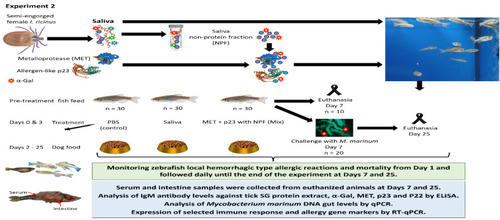
Experiment 2: Experimental design to evaluate the role of combined treatment with tick salivary proteins and fish tuberculosis. Saliva from semi-engorged I. ricinus female ticks was collected and used in this experiment. Wild type adult AB strain zebrafish (30 animals/group) were treated with PBS, saliva, and combined (Mix) tick salivary proteins metalloprotease (MET) + allergen-like p23 (p23) with saliva non-protein fraction (NPF). Zebrafish were kept on fish feed during pre-treatment and until Day 2. Zebrafish were injected via IM with each treatment at Days 0 and 3, and from Day 2 and until the end of the experiment at Days 7 and 25 fish were fed with dog food containing mammalian meat. At Day 7, 10 animals/group were euthanized by prolonged immersion using an overdose of tricaine methane sulfonate (MS222, 200–300 mg/l). The rest of the animals (n = 20) were challenged with M. marinum and maintained until Day 25 in which they were sacrificed. Zebrafish local hemorrhagic type allergic reactions and accumulated mortality were examined from Day 1 and followed daily until the end of the experiment at Days 7 or 25. After fish euthanasia, serum was collected individually to determine IgM antibody titers against tick salivary glands (SG) protein extract, α-Gal, tick proteins and the immunopurified subcomplex protein P22. Intestine samples were collected for expression analysis of selected immune response and allergy gene markers by RT-qPCR and the analysis of M. marinum DNA levels by qPCR.
|

